‘Into the Dark Abyss: Exploring South China’s Underground River System’ was first published as the cover story in our October 2019 issue. This story profiles the underwater caves in Guangxi, the adventurous people exploring them and the relationship between the Yao minority and South China’s underground river system.
On June 23, 2018, 12 young Thai boys and their assistant football coach wandered into a karst cave in northern Thailand, near the border with Myanmar. What happened next would captivate the world and lead to a complex and daring international rescue operation: The 10.3-kilometer-long Tham Luang cave flooded, trapping the boys in total blackness nearly 2.5 kilometers from the cave entrance.
Thousands of people from around the globe participated in the rescue effort, including military personnel, medical experts and – the rock stars of the operation – cave divers. The divers, who safely removed all of the Thai children and their coach after 18 days underground, dealt with tight spaces and low visibility in muddy water – conditions that would prove deadly: Saman Gunan, a former Thai Navy Seal, died while transporting air tanks into the cave.
While the sport of cave diving had received attention in the pop culture sphere prior to the rescue mission in North Thailand (see 2011’s Sanctum for reference), there is little doubt that the brave divers at Tham Luang cave helped thrust the activity and its myriad risks into global society’s collective psyche.

Divers prepare equipment outside Tham Luang cave in northern Thailand. Image via U.S. Air Force Capt. Jessica Tait h/t Wikimedia
The sport – often referred to as among the world’s most dangerous recreational activities – has its roots in pre-WWII England. Since then, the recreational practice of cave diving, described by Australian cave explorer Richard Harris (a participant in the Tham Luang cave rescue) as an “unusual hobby” for “ordinary blokes,” has spread around the world – China included.
Over 1,000 kilometers northeast of Tham Luang cave, in South China’s Guangxi Zhuang Autonomous Region, lies karst peak-covered Du’an county – China’s little-known cave diving mecca.
Home to thousands of kilometers of subterranean rivers, Du’an county offers divers spellbinding geological formations, perhaps the world’s largest collection of blind fish species and a rare variety of freshwater jellyfish.
Below, journey with us into underwater China and meet the folks exploring and documenting China’s spectacular underground river system.
Underwater China
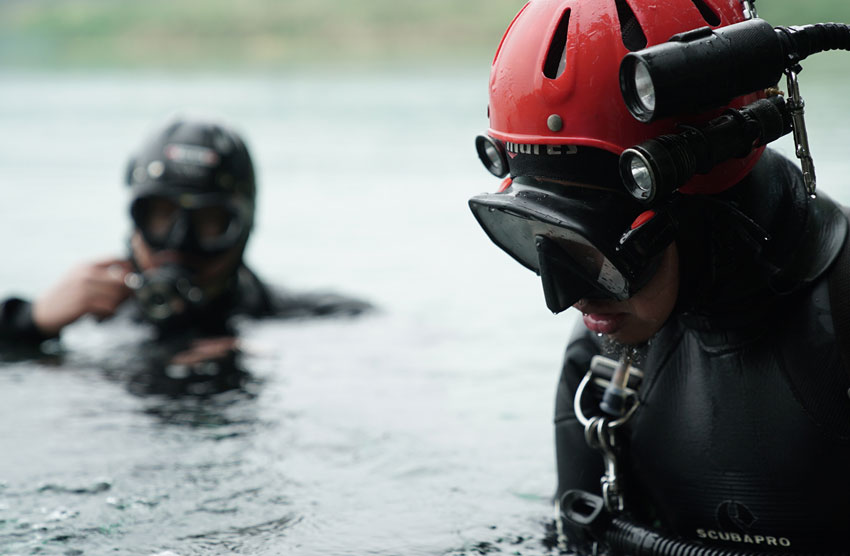
Divers in Du’an county. Image via Rachel Berkley
Located less than two hours from Guangxi’s capital city of Nanning, Du’an county is unquestionably remote and underdeveloped. Home to less than a million people, life here certainly moves slower than China’s larger metropolises. While researching for this article, the most recent English-language Du’an headline I came across was a Xinhua headline from late July that notes the county now has 3,583 kilometers of roads. Exciting stuff.
What the region lacks in electrifying headlines, however, it more than makes up for with its natural scenery. Home to the same stunning karst formations that run through Guizhou, Guangdong and into Southeast Asia, Du’an is an equally beautiful and far less touristy alternative to the world-famous Yangshuo. But it’s what’s under the ground that attracts a certain subset of modern-day explorers – cave divers.
Like much of South China’s karst-covered landscape, Du’an county (and Guangxi at large) is littered with caves, sinkholes and fissures. Many of these caves and underground geological formations are filled with water – running rivers, to be exact.

Divers inside a cave in Du’an county. Image via Rachel Berkley
“The water is flowing and, in some caves you go into, the current is quite strong. In others it is very calm,” says Rachel Berkley, a director and underwater cinematographer who filmed in the Du’an caves for an upcoming documentary series titled Underwater China. “In Guangxi alone, it is estimated that there are more than 10,000 kilometers of underground rivers.”
Berkley, a longtime Shanghai resident who is a PADI scuba diving instructor and PSAI cave diver, first became involved with the Underwater China team over a year and a half ago. When deciding what to feature in the first episode, the production team landed on China’s underground river system – and for good reason.
“The underwater cave formations in southern China are not only some of the most beautiful in the world – eerie and dark and winding, but they’re also home to some of the clearest water in China,” Berkley tells me. “That is why we decided to feature the caves for the show.”
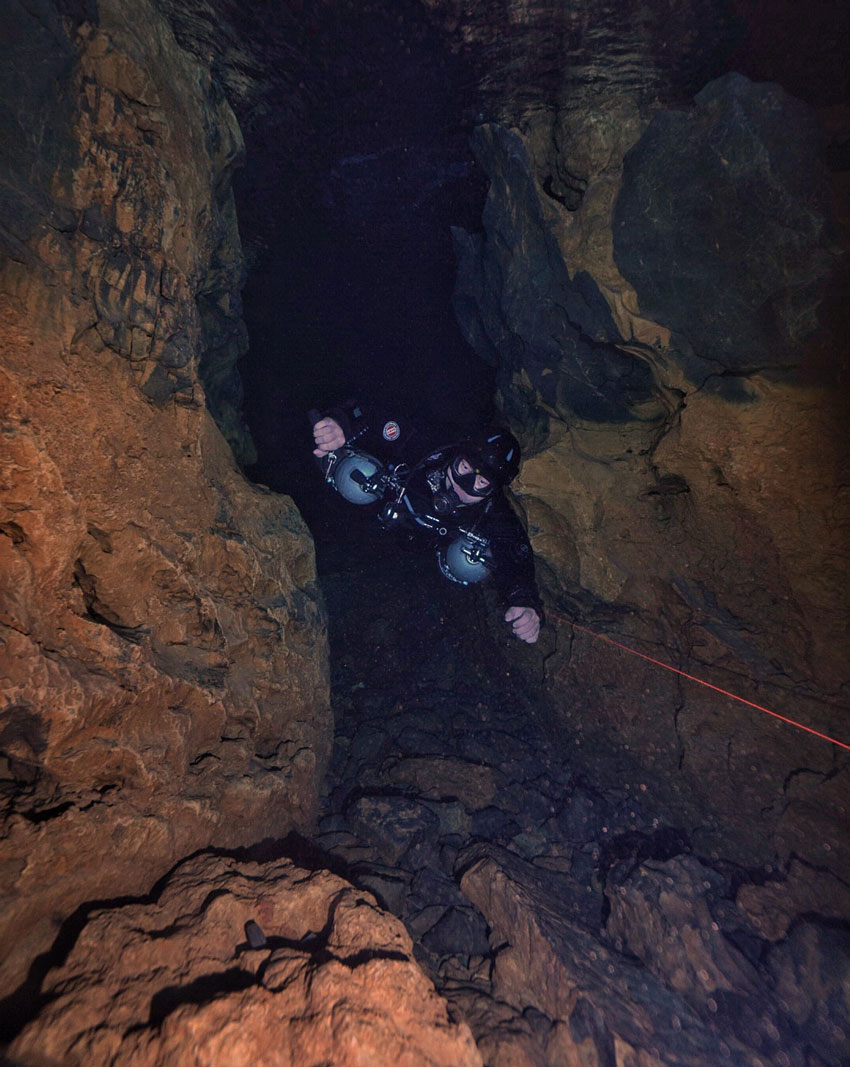
A diver exploring Lingwan cave in Du’an county. Image via Vincent Lou
Cave diving in Du’an began back in the 1970s, when a group of Russian divers visited the area to check out the underground rivers. They were followed by a group of Brits in the late ’80s, according to locals I spoke with. But the exploration of the area’s underwater world began in earnest in 2011, when a team of French divers arrived in Du’an.
“The first real mapping of the caves, and dedication to exploring the caves as cave diving sites, was from the French team,” says Berkley.
The French divers first arrived in 2011, after being informed of the caves’ existence by French caver Jean Botazzi, who was living and working in China at the time.
“He sent [us] some pictures. But the guy who organized everything was Sebastien Lissarrague,” French cave diver Pierre-Eric Deseigne tells me via email. “Without him, nothing would have happened. He organized the first two expeditions.” The French team split into two groups and made alternating return visits in 2012, 2013 and 2014.
Finding Footprints of the Past

The beautiful landscape surrounding Jiudun cave. Image by Matt Bossons/That’s
The journey from Flag Blue dive shop, which is located in Du’an’s Anyang town, to the Jiudun cave site takes just shy of an hour. It’s a drive that is unquestionably scenic, with karst peaks, lush green vegetation and small villages scattered along the route.
The Jiudun site is composed of three underwater caves: The North Cave and South Cave, both of which are extremely deep, and a shallower, shorter cave, which is only about 16 meters at its deepest penetrable point.
When we arrive at Jiudun, the site is largely deserted. Wei Le, a diver, driver and all-round handyman for Flag Blue, backs the dive shop’s pickup truck towards the large pond that serves as the entrance to all three caves. We unload our gear and suit up.
Han Ting, affectionally referred to by his students, peers and friends as ‘Lao Mao,’ is my guide and the leader of the dive. Originally from Hangzhou, Han is considered by many to be among China’s top tier of cave divers. Berkley, when pressed on Han’s credentials, tells me “he’s a leader in the industry.” Recruited by the local government in Du’an back in 2015, Han runs the county’s only dive center – a job he secured due to his underwater cave exploration in the United States and his experience in Mexico’s famed cenotes.
“The local government talked to many divers [about managing the dive center] and eventually they found me,” says Han. “We talked things through and they thought that I was the person to do it, so they invited me to come and set up here.”
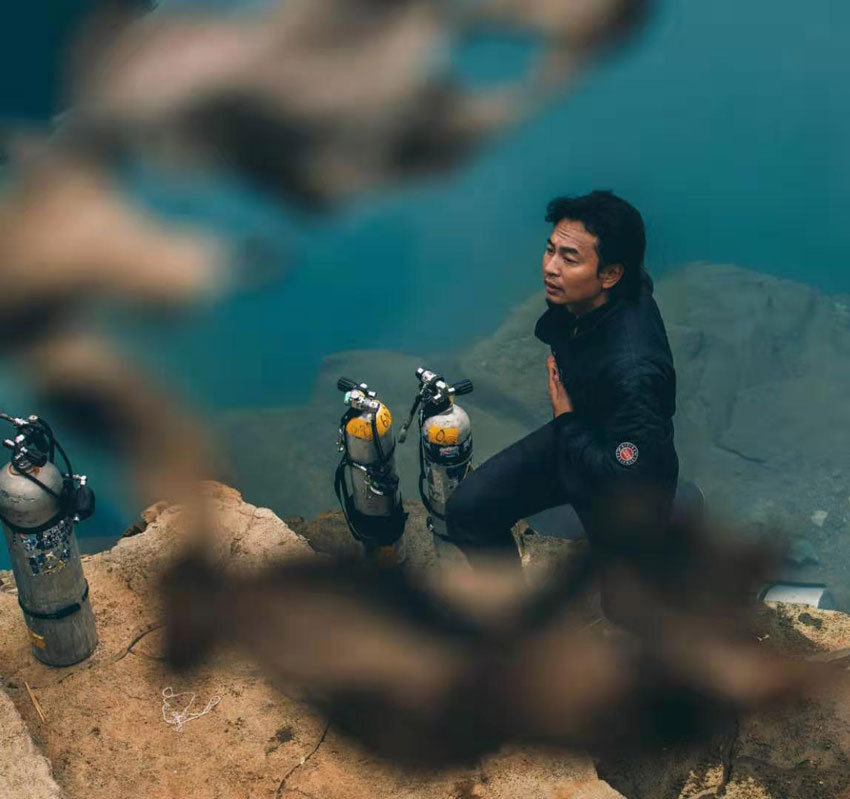
Han Ting. Image via Cara Chu Wai-ching
Inside the large pond above the Jiudun caves, Han runs me through buoyancy exercises, line drills and light signals. After about 20 minutes, we head into the shallower of the caves.
Visibility inside is about 10 meters, by my best estimate, maybe slightly less. The lights attached to Han’s red hardhat, along with the flashlight I carry, illuminate the path in front of us – the dull, green glow of the cave’s entrance fading as we move towards the end of the underwater chamber. Stalactites jut from the rock roof above us, and Han occasionally shines his light on interesting geological formations hidden in the darkness.
Upon reaching the end of the cave (the chamber does continue, although it is far too narrow for a diver to traverse), we turn around and Han trails me as I follow the guideline he laid back to the entrance.
According to research papers provided by Berkley, the underwater river system, which has been flowing for 270 million years, and the carbonate formations from Paleozoic ocean deposits are responsible for forming Du’an’s spectacular karst formations and caves.
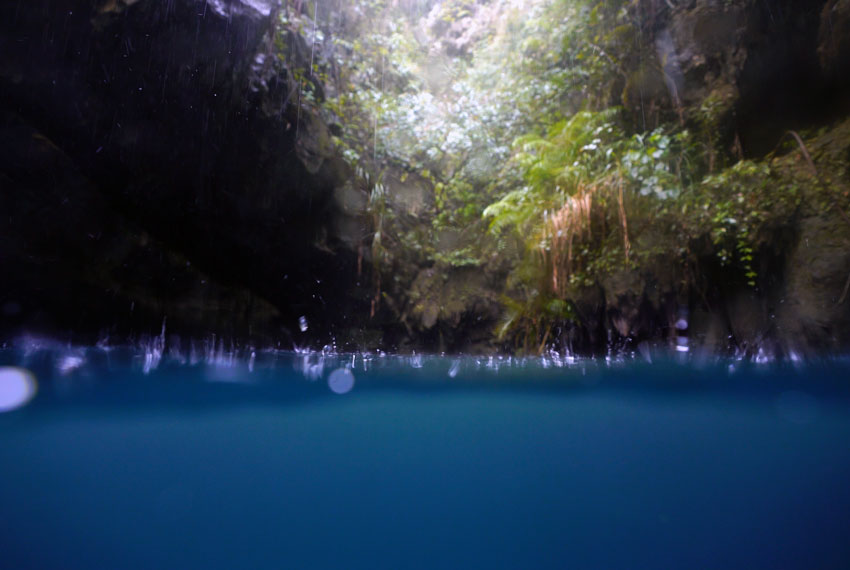
Peeking out of the entrance to Tunlie cave. Image via Rachel Berkley
As a result of their primeval origin, some of the caves possess true treasures from our planet’s past: Tunlie cave, otherwise known as ‘the fossil cave,’ contains a broad array of prehistoric fossils of aquatic creatures dating back to the Devonian Period (roughly 419.2 million to 358.9 million years ago). While filming for Underwater China, Berkley filmed and photographed in Tunlie and, hoping to learn more about the fossilized sea life, she posted her finds in a fossil forum, looking for feedback from experts.
“I got sent all these research papers from different paleontologists, and from what we can tell, those fossils should have been formed during the Devonian Period,” Berkley tells me. “So, the Devonian Period was called the ‘Age of Fish,’ because this is when bony fish began to flourish and the world was mostly underwater.
“I found a map of China during the Devonian Period and you just have little islands in what is now South China – so most of Guangxi was underwater and that is where these fossils came from.”
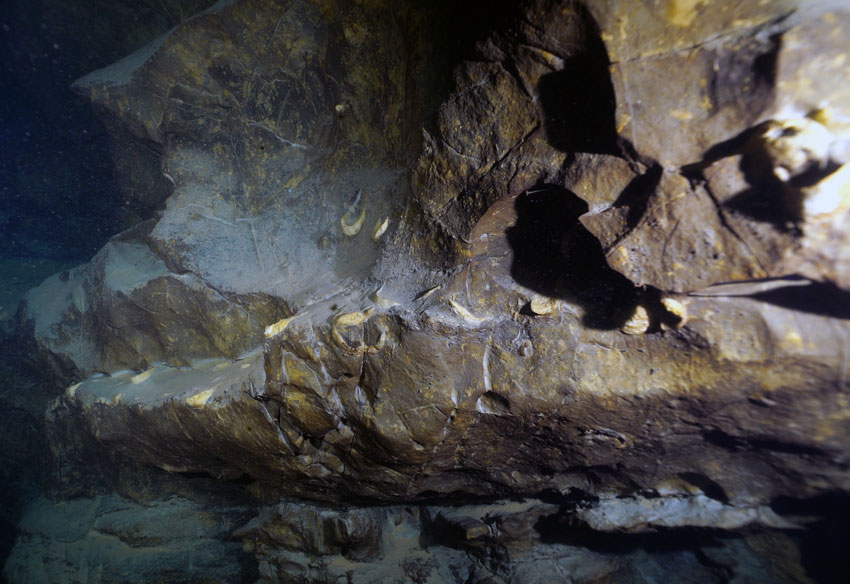
Fossils in Tunlie cave. Image via Rachel Berkley

Wei Le lowers equipment into Tunlie cave. Image via Rachel Berkley
Tunlie cave is the second dive site of the day for Han and myself. The entrance to the submerged chamber is located in a recess on a rocky hillside near a small village and entering the water requires us to climb down a metal ladder bolted into the rock. Our equipment – tanks, regulators and buoyancy control devices (BCD) – are lowered into the water-filled hole by Wei using a rope and climbing carabiners.
As on our previous cave penetration, Han leads the way, his headlights cutting through the all-consuming darkness as we follow a pre-set guideline into the bowels of the stone passageway.
The green glow of light from the entrance quickly dims behind us until it is just a dot in the distance. This time we go deeper, quickly descending to 10, then 20 and then 30 meters. On our left, a smorgasbord of rock ledges, stalactites, cracks, fossils and other geological formations emerge while below us our lights reveal that the cave’s bottom is entirely out of sight – shrouded in a seemingly impenetrable blackness.
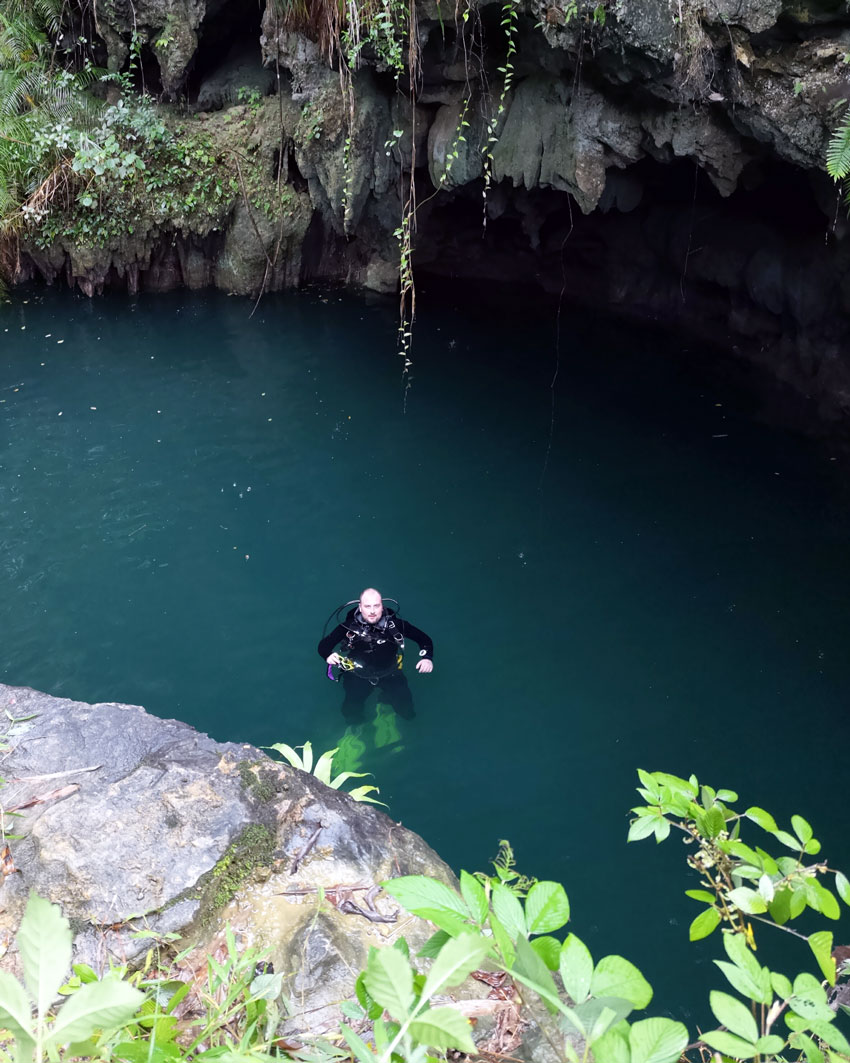
The author inside the entrance to Tunlie cave. Image via Wei Le
It’s at around the 20- to 30-meter mark that fossils begin to become visible in the limestone walls. Han waves his flashlight in my direction and then points out a beautifully preserved shell fossil that is comparable in size to a dinner plate.
We continue our descent until reaching 36 meters, at which point we begin ascending to an air pocket inside the cave.
“Don’t breathe the air in here too long,” Han tells me upon surfacing inside the subterranean air pocket. “Try to use your regulator to breath, we don’t know the quality of the air in here.” He points out roots from a tree above ground that have crept through the dirt and stone to access the cool, clean water in the cave.
After a few moments of taking in the natural wonder of the prehistoric space, we descend back into the black, watery abyss and start the final leg of our journey to the cave entrance.
READ MORE: Expedition Finds Giant Panda Fossils in China’s Longest Cave
The Den of the Gods
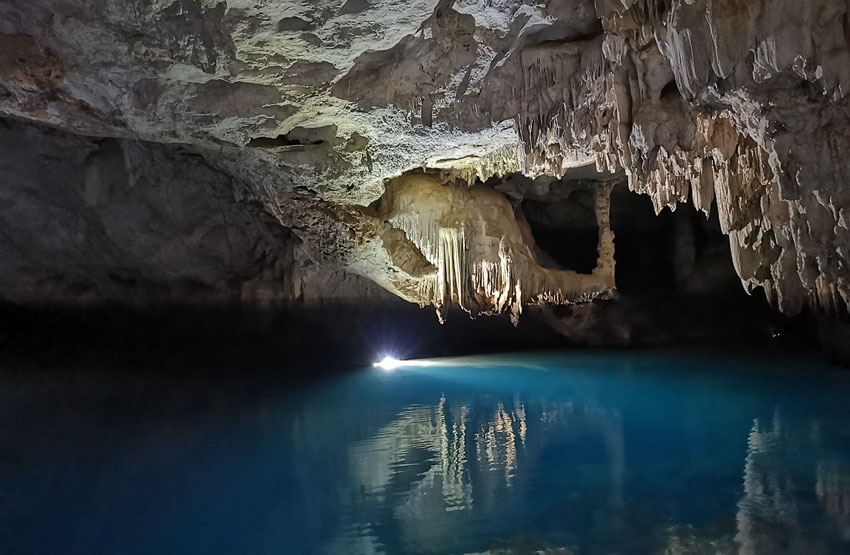
Inside Bailong cave in Du’an county. Image via Rachel Berkley
While the interior of Du’an’s caves may appear dark, cramped and barren on first look, they are home to a diverse array of lifeforms.
“China, as far as they can tell, has the world’s highest concentration of blind fish species, but no one really knows how many exist because the only way that they’ve been able to research these blind fish species is by examining what local farmers catch while fishing in the cave openings,” says Berkley. “During my research I found that China has around three times as many blind fish species as the next location, which is Mexico.”
And fish there are. During my soirees through Jiudun and Tunlie, small fish, ranging from a few centimeters in length to upwards of 20 centimeters, are seen inside the caves, darting in front of our lights at random. In the cave entrances, fish occasionally jump from the water – particularly at Jiudun, where more than a couple large fish break the water’s surface while we are setting up our gear.
A few of the caves are also home to a species of freshwater jellyfish that is native to China, the peach blossom jellyfish.
“These jellyfish are rare because they’re very sensitive and can only live in very specific water temperatures and pH levels. So, when you find these jellyfish, it means that the water is generally quite clean,” Berkley tells me. “People get very excited to find these types of jellyfish, because they are native to China. So, when they were discovered in Du’an years ago, the local government was super excited about it.”
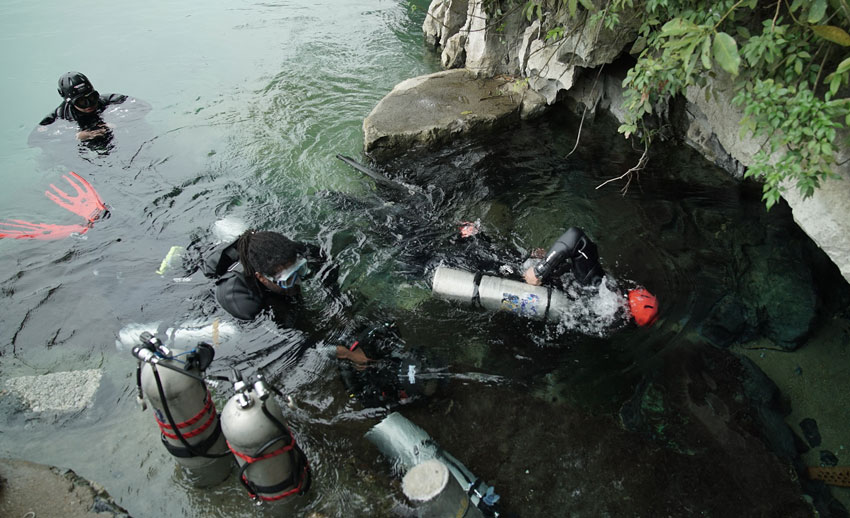
Divers at Lingwan cave. Image via Rachel Berkley
Local lore in Du’an attributes more than aquatic life to these caves, though: The local Bunu Yaozu people hold longstanding religious beliefs associated with the underground rivers.
According to the documents provided by Berkley, the Yao people have lived in the mountainous regions of South China since the Shang Dynasty. The Bunu Yao are a subgroup of this ethnicity and have long believed in a mother goddess known as Miluotuo, who is credited with creating human beings along with a whole host of gods. There is a water god, a mountain god, an earth god and, among myriad others, a god for the underwater river system.
Curious about the local folk religions, I question Han and Wei – who is a member of the Zhuang minority – on the long drive back to the dive center from Tunlie cave.
“Yes,” answers Han when I ask whether the locals have spiritual beliefs tied to the caves. “A lot of local superstitions are related to the caves. People here believe that each cave has a fairy.”
Wei then elaborates: “They aren’t really fairies; the locals believe that every cave has a rhinoceros inside, white rhinos. They are good luck in local cultural practice.”
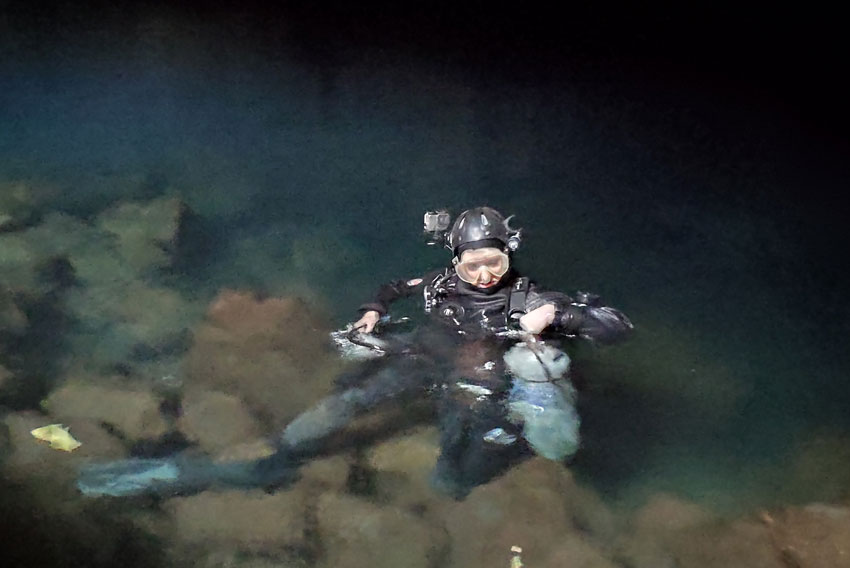
Rachel Berkley inside Bailong cave in Du’an county, completing a pre-dive surface check. Image via Rachel Berkley
Han goes on to explain that villagers living near some of the caves are wary of foreign divers entering their local underground rivers – fearful that they may steal the cave’s ‘white rhino.’
“They think that the foreign divers, they have some devices that can enlarge or shrink the rhino and steal it,” Wei adds.
The following day, I sit down for dinner with Yu Fei, a local restaurant owner and member of the Yao minority, in Anyang to chat about the caves and the area’s culture. Over barbecued lamb ribs and bowls filled with a local corn-based booze, I ask her about the cave rhinos.
“Yes,” she tells me, confirming the local belief, “this is the legend of the old people.”
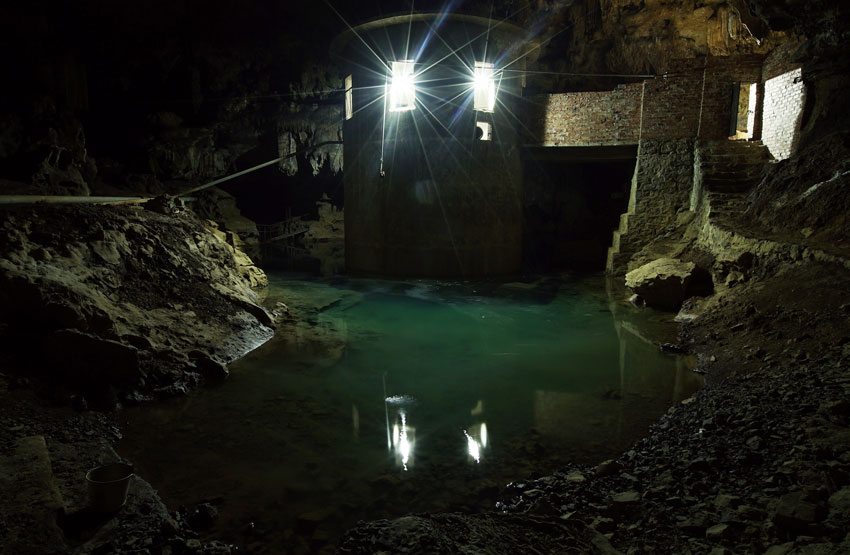
Red Army cave. Image via Rachel Berkley
There are other, more modern legends associated with the caves as well. In one Du’an village, there is a story about a group of bandits who terrorized the area in the 1950s, robbing and killing people before tossing their bodies into a nearby flooded cave. Han and his team have looked for human bones while diving in the cave, but ultimately came up empty handed.
“We didn’t find anything,” says Han. “We’ve only found animal bones in the caves, cows, bulls, birds, bats and snake bones.”
Dead Man Diving
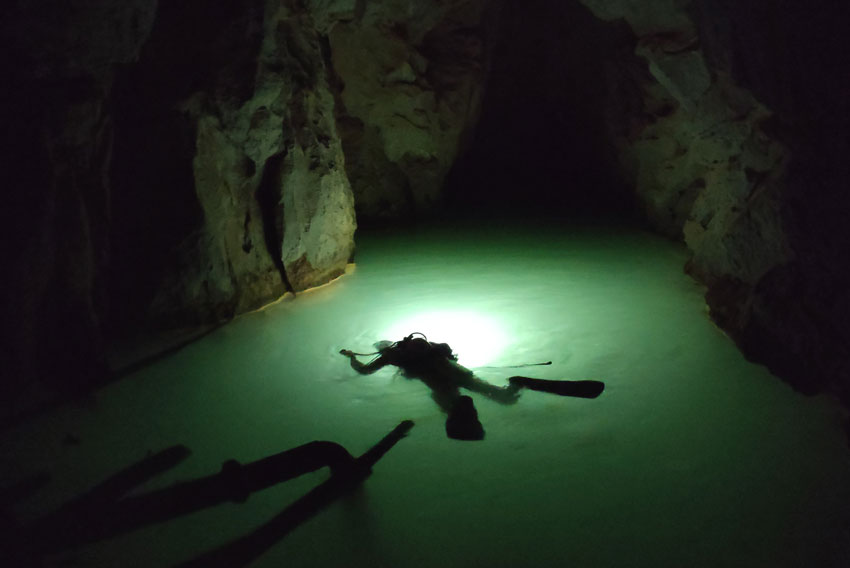
A diver inside ‘Blind Fish’ cave. Image via Rachel Berkley
As with any sport, there are records to be broken in cave diving and depth of dive is often the most talked about.
“The deepest dive I have done in the caves is 150 meters,” says Han. “The local record is 212 meters and was set by an Australian diver named Richard Harris, he was involved in the Thai cave rescue.”
But, with great reward comes great risks, and sometimes divers who undertake deep dives in confined spaces do not live to tell the tale.
Since cave diving began in Du’an, there has been one known fatality, which occurred back in 2014 in the North Cave of Jiudun. Two divers, both Chinese nationals, were attempting to set a record in the cave, according to Han, but at least one of them was not experienced enough to safely execute the dive plan.
“The deepest dive [the deceased man] had ever done before was 120 meters and they tried to go to 170 meters in a cave,” says Han. “He had done a couple of 100-meter dives in open water and a 120-meter dive in a cave, so he didn’t have the experience.”
Sadly, and perhaps predictably, tragedy struck: The inexperienced cave diver died during the dive, and his body had to be retrieved by a French cave diving team.
“About the Du’an accident, the lack of experience of the divers and the too-ambitious goal were the cause of the fatality,” says Deseigne. “Our team [recovered] the body of the diver. Sad story.”
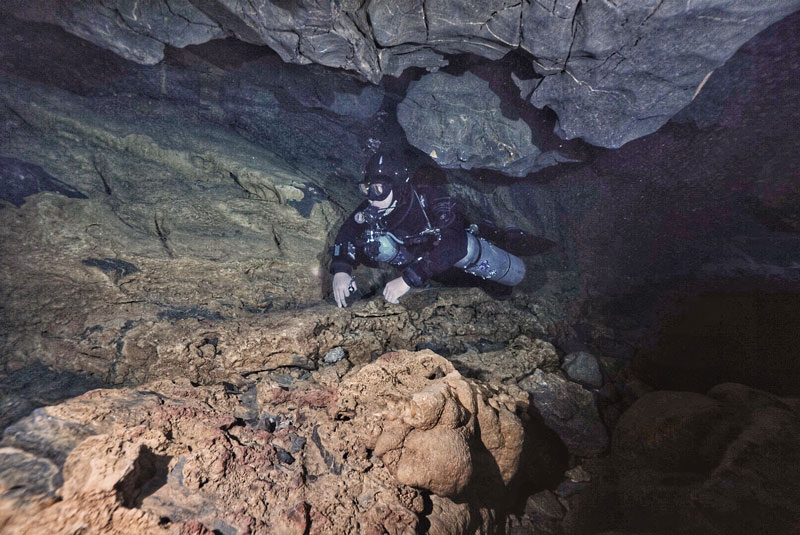
Diver in Du’an cave. Image via Vincent Lou

Inside Xia’ao cave. Image via Cara Chu Wai-ching
According to the Cave Diving Group, the representative body for cave divers in the United Kingdom, there were nine cave diver deaths between 1980 and 2005, with “the overall fatality rate for all dives … estimated at 1 in 3,286 dives.” The organization’s website notes that experience is the key variable in the deaths, and that “an experienced diver is estimated to be 25 times more likely to survive a dive than an inexperienced diver.”
In the years since this tragic accident, though, Du’an has avoided any further cave diving fatalities, something that many China-based divers and Du’an locals seem to attribute to Flag Blue dive center and Han’s professionalism and commitment to safety.
“[Cave diving] is absolutely risky, and Guangxi is very fortunate that there haven’t been more fatalities and that the diving community – Lao Mao and his group – are very responsible divers,” says Berkley, who was trained in cave diving with Han and dove extensively with him during filming for Underwater China.
“That death in the Guangxi caves was the exception, not the rule. In general, divers in Guangxi are very responsible and have had very few problems.”
If you found this story interesting, check out Underwater China on iQiyi. For more information about Du’an’s Flag Blue dive center, email ting@flagblue.cn or grecohan@gmail.com
[Cover image via Vincent Lou]
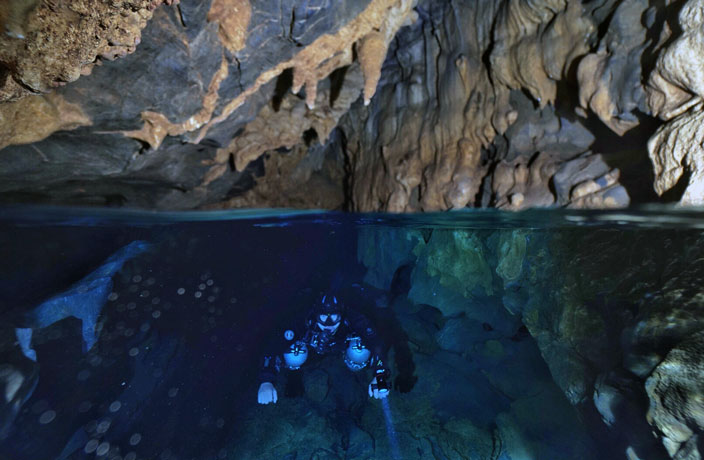





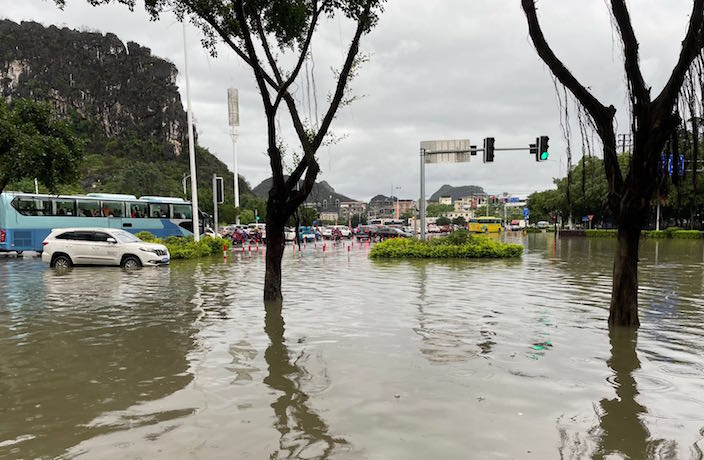














0 User Comments